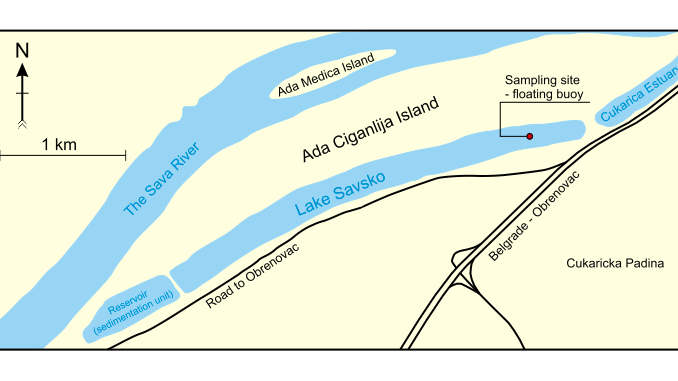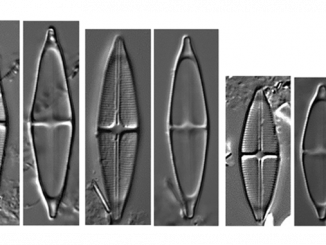
Paper category: Original research paper
Corresponding author: Ivana Trbojević (b3038_2014@stud.bio.bg.ac.rs)
DOI: 10.1515/ohs-2017-0038
Received: March 1, 2017
Accepted: April 14, 2017
Full text: here
Citation (APA style):
Abstract
Substrate specificity of the periphyton community is usually underestimated in both periphyton ecology and biomonitoring studies, thus different kinds of both natural and artificial substrates (of organic and inorganic origin) are employed. Periphyton colonization and successional trajectories are particularly debatable processes when different kinds of substrates are considered. In our field experiment, we deployed four kinds of artificial substrates (two inorganic ones – glass and ceramic, and two organic ones – willow and yew wooden tiles) for the development of periphyton in an urban reservoir referred to as Lake Savsko (Belgrade, Serbia). We comparatively investigated the structure, colonization process, diversity and successional trajectories of periphyton. We also assessed the relationship between the dynamics of algae growth forms (ecological groups) on different substrates and selected abiotic limnological factors. Our objective was to determine whether the type of substrate affects periphyton characteristics at various levels and whether an artificial substrate potentially affects the bioindication capacity of ecological groups. We concluded that all substrates behave similarly at the level of structure and colonization phases, but when considering diversity and successional trajectories, the substrate specificity was demonstrated. Our results suggest that communities developed on inert substrates (glass and ceramic) could provide more realistic insight into complex environmental changes.
References
Acker, F., Russell, B. & Morales, E. (2002). Preparation of Diatom Slides Using Naphrax™ Mounting Medium. In D.F. Charles, C. Knowles & R.S. Davis (Eds.) ANSP Protocols for Analysis of NAWQA Algae Samples (pp. 41-53). Philadelphia: The Academy of Natural Sciences of Philadelphia.
Ahn, C.H., Song, H.M., Lee, S., Oh, J.H., Ahn, H. et al. (2013). Effects of water velocity and specific surface area on filamentous periphyton biomass in an artificial stream mesocosm. Water 5(4): 1723-1740. DOI: 10.3390/w5041723.
Albay, M. & Akcaalan, R. (2008). Effects of water quality and hydrologic drivers on periphyton colonization on Sparganium erectum in two Turkish lakes with different mixing regimes. Environmental Monitoring and Assessment 146(1): 171-181. DOI: 10.1007/s10661-007-0069-5.
APHA (1995). Standard Methods for the Examination of Water and Wastewater 19th Edition. Washington, DC: American Public Health Association.
Azim, M.E., Verdegem, M.C.J., van Dam, A.A. & Beveridge, M.C.M. (2005). Periphyton: Ecology, exploitation and management. Cambridge: CABI Publishing.
Azim, M.E. & Asaeda, T. (2005). Periphyton structure, diversity and colonization. In M.E. Azim, M.C.J Verdegem, A.A. van Dam & M.C.M. Beberidge (Eds.), Periphyton: Ecology, Exploitation and Management (pp.15-33). Cambridge, CABI Publishing.
B-Béres, V., Lukács, Á., Török, P., Kókai, Z., Novák, Z. et al. (2016). Combined eco-morphological functional groups are reliable indicators of colonisation processes of benthic diatom assemblages in a lowland stream. Ecological Indicators 64: 31-38. DOI: 10.1016/j.ecolind.2015.12.031.
Biggs, B.J.F. (1996). Patterns in Benthic Algae of Streams. In R.J. Stevenson, M.L. Bothwell & R.L. Lowe (Eds.), Algal Ecology: Freshwater Benthic Ecosystems (pp. 31-58). San Diego, CA: Academic Press.
Biggs, B.J.F., Stevenson, R.J. & Lowe, R.L. (1998). A habitat matrix conceptual model for stream periphyton. Archiv für Hydrobiologie. 143(1): 21-56. DOI: 10.1127/archiv-hydrobiol/143/1998/21.
Blaženčić, J. (1995). Floristic characteristics of the macrophytic vegetation in Lake Savsko near Belgrade (Serbia, Yugoslavia). Bulletin of the Institute of Botany and Botanical Garden Belgrade. 29: 167-173.
Borduqui, M. & Ferragut, C. (2012). Factors determining periphytic algae succession in a tropical hypereutrophic reservoir. Hydrobiologia 683(1): 109-122. DOI: 10.1007/s10750-011-0943-6.
Carlson, R.E. & Simpson, J.T. (1996). A coordinator’s guide to volunteer lake monitoring methods. Madison: North American Lake Management Society.
Cattaneo, A. & Amireault, M.C. (1992). How artificial are artificial substrata for periphyton? Journal of the North American Benthological Society 11(2): 244-256. DOI: 10.2307/1467389.
Danilov, R.A. & Ekelund, N.G.A. (2001). Comparison of usefulness of three types of artificial substrata (glass, wood and plastic) when studying settlement patterns of periphyton in lakes of different trophic status. Journal of Microbiological Methods. 45(3): 167-170. DOI: 10.1016/S0167-7012(01)00247-0.
DeNicola, D.M., De Eyto, E., Wemaere, A. & Irvine, K. (2006). Periphyton response to nutrient addition in 3 lakes of different benthic productivity. Journal of the North American Benthological Society 25(3): 616-631. DOI: 10.1899/0887-3593(2006)25[616:PRTNAI]2.0.CO;2.
Dunck, B., Rodrigues, L. & Bicudo, D.C. (2015). Functional diversity and functional traits of periphytic algae during a short-term successional process in a Neotropical floodplain lake Brazilian Journal of Biology 75(3): 587-597. DOI: 10.1590/1519-6984.17813.
EN 15204 (2006). Water Quality – Guidance Standard on the Enumeration of Phytoplankton using Inverted Microscopy (Utermohl Technique). Brussels: European Committee for Standardization.
França, R.C.S., Lopes, M.R.M. & Ferragut, C. (2011). Structural and successional variability of periphytic algal community in a Amazonian lake during the dry and rainy season (Rio Branco, Acre). Acta Amazonica 41: 257-266. DOI: 10.1590/S0044-59672011000200010.
Gottschalk, S. & Kahlert, M. (2012). Shifts in taxonomical and guild composition of littoral diatom assemblages along environmental gradients. Hydrobiologia 694(1): 41-56. DOI: 10.1007/s10750-012-1128-7.
Hillebrand, H. & Sommer, U. (2000). Diversity of benthic microalgae in repsonse to colonization time and eutrophication. Aquatic Botany 67(3): 221-236. DOI: 10.1016/S0304-3770(00)00088-7.
ISO 10260 (1992). Water Quality – Measurement of biochemical parameters – Spectrometric determination of the chlorophyll-a concentrations. Geneva: International Organization for Standardization.
Janković, M.M. & Janković, J.M. (1987). Contribution to the knowledge and solution of eutrophication and overgrowing problem of the Sava Lake (Ada Ciganlija) near Beograd. Bulletin of the Institute of Botany and Botanical Garden Belgrade 16: 1-41.
Kiss, M.K., Lakatos, G., Borics, G., Gidó, Z. & Deák, C. (2003). Littoral macrophyte-periphyton complexes in two Hungarian shallow waters. Hydrobiologia 506(1): 541-548. DOI: 10.1023/B:HYDR.0000008594.48184.ca.
Kralj, K., Plenković-Moraj, A., Gligora, M., Primc-Habdija, B. & Šipoš, L. (2006). Structure of periphytic community on artificial substrata: influence of depth, slide orientation and colonization time in karstic Lake Visovacko, Croatia. Hydrobiologia 560(1): 249-258. DOI: 10.1007/s10750-005-1330-y.
Lakatos, G. (1989). Composition of reed periphyton (biotecton) in the Hungarian part of lake. Biologisches Forschungsinstitut fur Burgenland. 71: 125-134.
Larson, C.A. & Passy, S.I. (2012). Taxonomic and functional composition of the algal benthos exhibits similar successional trends in response to nutrient supply and current velocity. FEMS Microbiology Ecology 80: 352-362. DOI: 10.1111/j.1574-6941.2012.01302.x.
Martinovic-Vitanovic, V., Milankov, V. & Kalafatic, V. (2010). First record of freshwater bryozoans (Bryozoa: Phylactolaemata) in the aquatic invertebrate fauna of Serbia. Limnologica 40(1): 73-81. DOI: 10.1016/j.limno.2009.04.001.
Mićković, B., Nikčević, M., Grozdić, T., Pucar, M., Hegediš, A. et al. (2014). Ecological Potential Assessment of Sava Lake Based on Fish Community Composition: Preliminary Results. Water Research and Management 4(3): 21-25.
Mihaljević, M. & Pfeiffer, T.Ž. (2012). Colonization of periphyton algae in a temperate floodplain lake under a fluctuating spring hydrological regime. Fundamental and Applied Limnology 180(1): 13-25. DOI: 10.1127/1863-9135/2012/0210.
Passy S.I. (2007). Diatom ecological guilds display distinct and predictable behavior along nutrient and disturbance gradients in running waters. Aquatic Botany 86(2): 171-178. DOI: 10.1016/j.aquabot.2006.09.018.
Pielou, E.C. (1969). An introduction to mathematical ecology. New York: Wiley-Interscience.
Rimet, F. & Bouchez, A. (2012). Life-forms, cell-sizes and ecological guilds of diatoms in European rivers. Knowledge and Management of Aquatic Ecosystems 406: 01. DOI: 10.1051/kmae/2012018.
Rimet, F., Bouchez, A. & Montuelle, B. (2015). Benthic diatoms and phytoplankton to assess nutrients in a large lake: complementarity of their use in Lake Geneva (France-Switzerland). Ecological Indicators 53: 231-239. DOI: 10.1016/j.ecolind.2015.02.008.
Romanów, M. & Witek, Z. (2011). Periphyton dry mass, ash content, and chlorophyll content on natural substrata in three water bodies of different trophy. Ocean. Hydrobiol. St. 40(4): 64-70. DOI: 10.2478/s13545-011-0042-3.
Sabater, S., Gregory, S.V. & Sedell, J.R. (1998). Community dynamics and metabolism of benthic algae colonizing wood and rock substrata in a forest stream. Journal of Phycology 34(4): 561-567. DOI: 10.1046/j.1529-8817.1998.340561.x.
Schneck, F. & Melo, A.S. (2012). Hydrological disturbance overrides the effect of substratum roughness on the resistance and resilience of stream benthic algae. Freshwater Biology 57: 1678-1688. DOI: 10.1111/j.1365-2427.2012.02830.x.
Serbian Hydrometeorological Institute (2015). Seasonal Bulletin for Serbia, summer 2014. Belgrade: Serbian Hydrometeorological Institute. (In Serbian).
Shannon, C.E. & Weaver, W. (1949). The mathematical theory of communication. Urbana: University of Illinois Press.
Shevchenko, T.F. (2011). Distribution of periphyton algae of the Dnieper Reservoirs depending on the type of substratum. Hydrobiological Journal 47(3): 3-13. DOI: 10.1615/HydrobJ.v47.i3.10.
Stancheva, R. & Sheath, R.G. (2016). Benthic soft-bodied algae as bioindicators of stream water quality. Knowledge and Management of Aquatic Ecosystems 417: 15. DOI: 10.1051/kmae/2016002.
Stenger-Kovács, C., Lengyel, E., Crossetti, L.O., Üveges, V. & Padisák, J. (2013). Diatom ecological guilds as indicators of temporally changing stressors and disturbances in the small torna-stream, Hungary. Ecological Indicators. 24: 138-147. DOI: org/10.1016/j.ecolind.2012.06.003.
Tapolczai, K., Bouchez, A., Stenger-Kovács, C., Padisák, J. & Rimet, F. (2016). Trait-based ecological classifications for benthic algae: review and perspectives. Hydrobiologia 776(1): 1-17. DOI 10.1007/s10750-016-2736-4.
ter Braak, C.J.F. & Šmilauer, P. (2012). Canoco reference manual and user’s guide: software for ordination, version 5.0. Ithaca, USA: Microcomputer Power.
Zhang, N., Li, H., Jeppesen, E. & Li, W. (2013). Influence of substrate type on periphyton biomass and nutrient state at contrasting high nutrient levels in a subtropical shallow lake. Hydrobiologia 710(1): 129-141. DOI: 10.1007/s10750-012-1287-6.
Žuna Pfeiffer, T., Mihaljević, M., Špoljarić, D., Stević, F. & Plenković-Moraj, A. (2015). The disturbance-driven changes of periphytic algal communities in a Danubian floodplain lake. Knowledge and Management of Aquatic Ecosystems 416: 02. DOI: 10.1051/kmae/2014038.


Bądź pierwszy, który skomentuje ten wpis